There’s nothing more frustrating than finding color bleed stains in the wash. It happens to the best of us. That pesky red sock gets caught up with your best white shirt, and hey presto! You’re rocking a shirt covered in pink polka dots. Is it fixable? Can you get color bleed out of clothes?
Color bleed happens when a color runs out of one garment into another. This can cause streaks or blotches. These stains can be removed by using a commercial stain remover. They can also be removed with natural remedies like vinegar or baking soda. Rubbing alcohol, bleach, and hydrogen peroxide are all good for stubborn stains.
Fear not, your garments can be saved after a color bleed accident. In this article, we’ll walk you through the methods you can use. You’ll also discover how to prevent color bleeds from happening in the future.
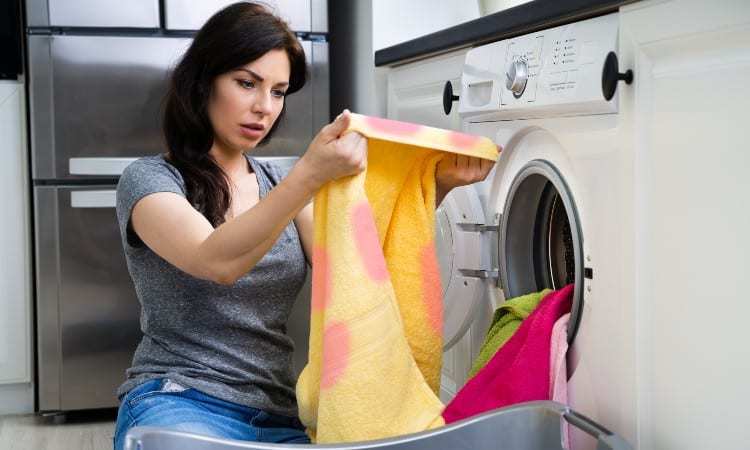
Quick Navigation
What Causes Color Bleed?
The number one cause of color bleed is accidentally mixing dark-colored clothing with light garments in the wash. This one reason has happened to all of us at one time or another.
If you’re like me, you’ve probably been told from an early age to wash dark colors separately. This advice has stood the test of time from generation to generation. It’s such a pity it’s easier said than done.
Whether it’s down to static holding different clothes together or simply being in a rush, garments get entwined with each other. Especially when they are dumped in the same washing basket. You grab a load, shove it in the drum and turn on the washer.
Not until the wash cycle has completed do you realize the full horror within. Your favorite yellow dress has turned a weird shade of orange. Some white socks have gone pink, and your beige shorts have pink spots. The culprit, your new, postbox red t-shirt.
The problem with new clothes, in particular, is they are not always colorfast. It’s normal for some of the color to bleed out in the first few washes. New jeans, for instance, are notorious for bleeding blue dye when they get wet. This is why older jeans look faded. It’s because frequent washes have caused the color to ooze out into the water.
Dye doesn’t really like being in the water; it prefers to attach to the fabric. But, it’s not fussy about going back into the original garment. Oh deary me, no. Our lives would be a lot simpler if it did! It’ll adhere itself to any material it can soak into. When this happens, it’s known as color bleed.
New garments aren’t the only baddies when color bleed through. The dreaded, unintentional tie-dye effect on your best white shirt could also be caused by heat.
One of the biggest factors in laundry accidents is not reading the care label on the garment. This label will give a recommended wash temperature. Especially for colored clothes which may not be able to withstand a hot wash. If your garment’s label says wash in cold water, and you wash it in warm, the chances of color bleed increase. Wash the clothing in hot water, you risk a veritable tsunami of color seeping into your other clothes.
How to Get Color Bleed Out of Clothes
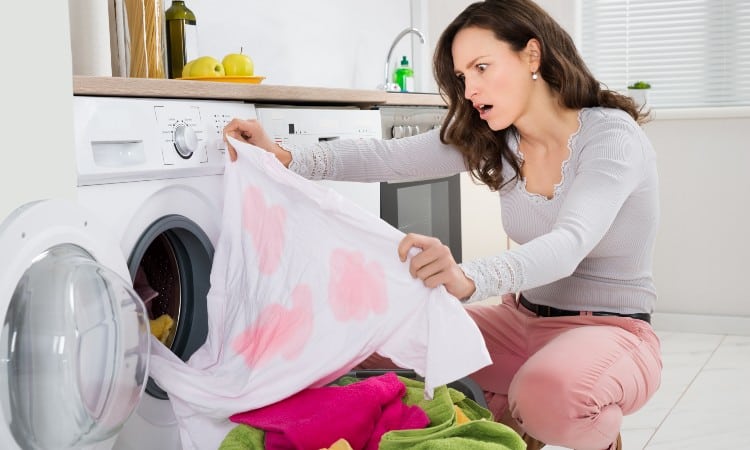
After the initial and completely understandable outburst of fury, your next thought is one of sheer panic. How the heck did that red shirt get in with your white socks? Followed by how on earth can you fix it?
The good news is, if you catch a color bleed as soon as you take the clothes out of the washing machine, the chances of repairing the damage are better. You could find all you need to do is rewash the dyed clothing with laundry detergent. Chuck it back in the machine while it’s still wet and use the normal wash cycle for the garment. Just make sure to remove the item that caused the color run in the first place!
If that doesn’t do the trick, you will need some help from stain-removing products. A word of caution here, none of these methods are 100% guaranteed to work. It depends on the type of dye, the fiber content of the clothing, and the method you choose.
In this section, we’ll take a look at the top remedies and explore the situations they are best suited for. As always, when using products on your clothing, check the garment label to make sure your chosen remedy isn’t going to make things worse. Bleach, for instance, will strip the base color out of a garment and the color run stains. It will also attack any polyester content.
1. White Vinegar
 White vinegar is the unsung hero of the kitchen cupboard. It has so many other uses than as a condiment for flavoring food. You can use it for cleaning and for removing stains.
White vinegar is the unsung hero of the kitchen cupboard. It has so many other uses than as a condiment for flavoring food. You can use it for cleaning and for removing stains.
Vinegar is a natural acid and will strip stains and colors. It can’t tell the difference between colors you want to keep and those you don’t. So proceed with caution. Only use vinegar if you are removing color bleed accidents from colorfast garments.
Method 1
You will need:
- Distilled white vinegar
- Large bowl or sink
- Cotton balls
Step 1
Before you decide to use vinegar on your color bleed stains, test the garment to make sure it’s colorfast. To do this, soak a cotton ball with vinegar and rub it on an inconspicuous area. As long as none of the garment’s color lifts off onto the cotton ball, it’s going to be OK to use vinegar.
Step 2
Fill a bowl or sink with enough water to completely cover your garment. Add one cup of white vinegar and mix well.
Step 3
Submerge your garment in the solution and leave it to soak for about 30 minutes. You want to make sure every part of the clothing is covered by the vinegar and water mixture.
Step 4
Rinse out the vinegar using cold water. Make sure to get as much out as you can. Check the clothes for signs of color bleed stains. If you still have some, repeat steps 1-4.
Once you are happy, all the stains have been removed. Wash your garment with your usual detergent and on your normal wash setting. Allow to air dry.
Method 2
Vinegar can also be used as a spot treatment. If your whole garment hasn’t been affected by the color bleed, try the following steps.
You will need:
- Distilled white vinegar
- Clean rag
- Small bowl
- Lukewarm water
- Dish soap
Step 1
Mix the water and vinegar in the bowl. The quantity you use will depend on the size of the stain you want to treat. As a rule of thumb, you need a 2:1 ratio. So for every two cups of water, you need 1 cup of vinegar. Make sure the bowl you use is big enough to hold the mixture and allow for mixing.
Step 2
Add a spoonful of dish soap to the mixture. No more than a tablespoon. Again, the actual amount will depend on the amount of vinegar and water you are using. For a small mix, a teaspoon should suffice. Stir the concoction until you have bubbles.
Step 3
Dip your clean rag into the solution and use it to blot the stain. Avoid any rubbing, scrubbing, or swirling motions. You only want to dab or blot at the stain. Rubbing will make the color bleed spread. As you blot, you should see the color stain lift out and adhere to the rag.
Step 4
As soon as the rag changes color, switch to a clean section and repeat the dabbing process. Keep doing this until all the color bleed has been soaked up by the rag.
Step 5
Once you are happy all the stain has been removed, you can rinse the vinegar. You can hold it under a running faucet for this, and make sure the water is cold.
Step 6
Wash your garment as you would normally. Avoid using the dryer. It’s best to let the garment air dry.
2. Baking Soda
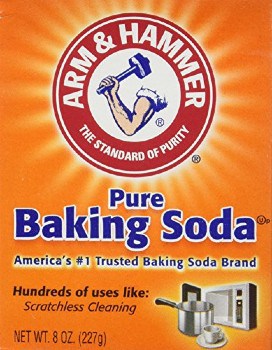 Baking soda can be used for a whole host of cleaning jobs. It works best when mixed up into a paste and left to soak up any stain residue. This makes it the perfect choice for pre-treating dried color bleed stains.
Baking soda can be used for a whole host of cleaning jobs. It works best when mixed up into a paste and left to soak up any stain residue. This makes it the perfect choice for pre-treating dried color bleed stains.
You will need:
- Baking soda
- Warm water
- Teaspoon
- Large bowl or sink
- Cardboard
Step 1
Mix a solution of warm water and baking soda until you have a smooth paste. The quantities you use depend on the size of stain you are treating. To a certain extent, you may have to work by eye on this one. Simply mix up what looks like enough for the stain. You can always make more. The key is, the paste needs to be thick but spreadable. So no bumps, lumps, or flakes.
Step 2
Put the cardboard inside the garment, underneath the stain. You want to make sure the color bleed doesn’t get pushed straight through the item and end up staining the back of the garment. The cardboard will catch any escaping color, keeping the back free from dye damage.
Step 3
Coat the stain with the paste. Using the back of the teaspoon, gently work the baking soda mix into the stain. Make sure it’s covered well.
Step 4
Allow the mix to dry overnight. This will ensure the baking soda can soak up as much of the color bleed as possible.
Step 5
Scrap off the baking soda mixture into your sink. Wash your garment with your usual laundry detergent. Set your washing machine on a cool setting.
Step 6
Check your garment for signs of color bleed. If you are happy, they have all been removed, allow your garment to air dry. If some residual staining is still present, don’t dry the garment. Simply repeat steps 1-5 until you are satisfied with the results.
3. Rubbing Alcohol
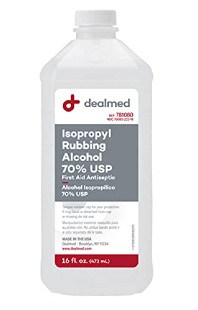 Isopropyl alcohol, or rubbing alcohol, is a tried and tested stain remover. It has been used for generations on all sorts of stains. Similarly to baking soda, this method works best for spot treatments rather than whole garments.
Isopropyl alcohol, or rubbing alcohol, is a tried and tested stain remover. It has been used for generations on all sorts of stains. Similarly to baking soda, this method works best for spot treatments rather than whole garments.
Before you use rubbing alcohol, check your garment for fiber content. Although it is usually safe to use isopropyl alcohol on material, you should double-check your garment to make sure it is compatible.
You will need:
- Isopropyl alcohol
- Cardboard
- Cotton balls
Step 1
Lay your garment flat on a smooth surface like a table. Place the cardboard inside the garment so it can catch any drips of rubbing alcohol and removed stain. This will prevent the stain from relocating to a different part of the fabric.
Step 2
Pour rubbing alcohol onto a cotton ball until it is soaked. Use the cotton ball to dab at the stain on the garment. Continue to apply the cotton ball with a blotting motion. Don’t rub. The stain will begin to lift out of the garment and adhere to the cotton ball. As soon as you see this, change to a fresh cotton ball. Carry on blotting until as much of the stain has been removed as possible.
Step 3
If you can still see residual dye, it may be on the inside of the garment. Turn it inside out and dab the inside with a cotton ball. This will help lift any dye that has soaked through. Then rinse the garment under cold running water.
Step 4
Wash the garment using your usual laundry detergent. Make sure to keep your washing machine on a cold setting. Check for signs of stains once the cycle is complete. If you can still see some, repeat steps 1-4 until you are happy they are all gone.
Once you are satisfied, allow your garment to dry naturally. Using a dryer may set the alcohol as a stain, so you need to avoid heat for this first wash after treatment.
4. Hydrogen Peroxide
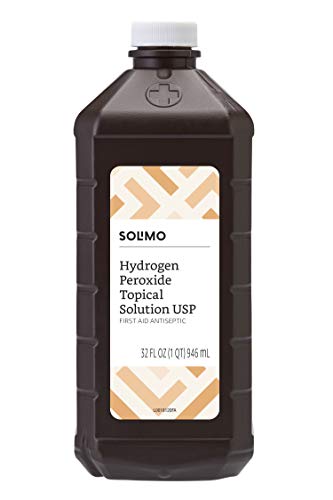 Hydrogen peroxide is a type of bleach. Milder than chlorine bleach, hydrogen peroxide can be used to treat wounds and strip color from hair. Its color removing qualities make it an ideal product for stain removal.
Hydrogen peroxide is a type of bleach. Milder than chlorine bleach, hydrogen peroxide can be used to treat wounds and strip color from hair. Its color removing qualities make it an ideal product for stain removal.
Care should be taken before using it. As it’s a mild bleach, it can damage some textiles. Always check your garment’s care label for fiber content before applying hydrogen peroxide to your clothing. This product works best to remove spots rather than the color from a complete garment.
Due to it being a milder form of bleach, hydrogen peroxide is safer to use on colored garments. It shouldn’t remove the original color of the garment in the same way a full-strength bleach will. Test a small inconspicuous area first before committing to this method.
You will need:
- Hydrogen peroxide
- Cotton balls
- Cardboard
Step 1
Test a small area by performing a spot test. Take a cotton ball and soak it with hydrogen peroxide. Apply this to an inconspicuous area. As long as none of the color from the garment comes off onto the cotton ball, it’s safe to use Hydrogen Peroxide. If you see color on the cotton ball, choose a different method.
Step 2
Lay your garment flat and insert the cardboard between the top and bottom layers. It needs to be directly under the stain.
Step 3
Soak a cotton ball with hydrogen peroxide and blot the stain. The color bleed stain should lift out of the garment and onto the cotton ball. As the dye lifts and soaks the cotton ball, change the ball to a clean one. Keep going until the color stops staining the cotton balls.
Step 4
Rinse the garment under cold running water to remove the hydrogen peroxide. Then wash using your usual detergent. Make sure the garment is washed on its own on a cold setting. Check for stains once the cycle is complete. If you are happy with the results air dry your garment.
If you are not satisfied with the results, repeat steps 1-4 until you are. At no point should you be tempted to dry your garment in the dryer. The heat may react with the hydrogen peroxide and cause a bleach stain.
5. Oxygen Bleach
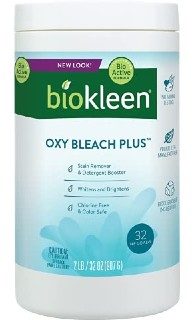 Oxygen bleach is a safe laundry alternative to chlorine bleach. Not as stringent as chlorine, it is a favorite stain removing addition to laundry rooms across the globe. Considered a safer alternative for colored garments, oxygen bleach can contain hydrogen peroxide.
Oxygen bleach is a safe laundry alternative to chlorine bleach. Not as stringent as chlorine, it is a favorite stain removing addition to laundry rooms across the globe. Considered a safer alternative for colored garments, oxygen bleach can contain hydrogen peroxide.
This product works on whole garments rather than spot stains. For colored items, make sure to test for potential damage on an inconspicuous area before performing a full treatment. Check your garment’s care label before using it to make sure the fiber content is compatible.
You will need:
- Oxygen bleach
- Bucket or sink
- Cold water
Step 1
Fill your bucket or sink with enough water to completely submerge your garment. Add 1 cup of oxygen bleach.
Step 2
Leave the garment to soak in the solution for around 30 minutes. After the allotted time, rinse the garment under cold running water. If the stain is still visible, give the garment another 30 minutes in the bleach soak and then rinse again. Keep doing this step until you are happy with the results.
Step 3
Wash the garment using your usual detergent. Your machine should be set for a cold wash. Once the cycle has ended, re-check for signs of stains. If you are happy, allow your garment to air dry.
6. Commercial Stain Removers
Up to this point, we’ve looked at natural remedies and items already found in your laundry room. You can also purchase commercial color bleed and stain removers. These products are designed specifically for removing those pesky color run accidents and stains in general.
Although they are tested and considered safe for use on apparel stains, you should always do a spot test on an inconspicuous area to make sure your garment will survive a stain removal treatment.
Normally, a commercial product is designed as a prewash stain remover. Because of this, you may find they work better on a whole garment rather than as a spot removal method.
Color run removers and stain removers will have instructions for their use on the packets. Always follow the manufacturer’s instructions for best results.
Can You Remove Color Bleed After Drying?

Yes, you can, but it won’t be as easy as before it has been dried. Color bleed stains or accidental color runs are best removed as soon as they happen. Allowing a stain to dry, or drying a garment with stains in a dryer, will help set the stains. Making their removal problematic and less likely to succeed.
Most of the remedies mentioned in this article work on wet garments. Once a color bleed stain has been dried, you may only have one option you can use. You might have to resort to using a commercial stain remover. Using a chemical color remover might improve your chances of reversing the damage.
However, even a chemical remover may struggle to lift out a dried stain. It may be simpler to incorporate the bleed as part of a tie-dye design. While you might not be able to remove the stain, you could make it a part of an intentional dye technique to personalize your clothing.
Best Natural Method for Getting Color Bleed Out of White Clothes?
The best natural method for getting rid of color bleed stains is to use white vinegar. It will work on white clothes and colored garments. Although you have to make sure the colored clothing is colorfast before using it. A downside with vinegar, or any stain remover, is it can’t tell the difference between a stain and color you want to keep.
Vinegar is acidic and can remove a multitude of household stains, not just color bleed accidents in the laundry. Even better news, white vinegar is safer to use than bleach. It doesn’t have the same pungent smell, nor will it burn your skin if you spill it.
You can also safely use it if you have a septic system rather than city sewage. Your vinegar solution isn’t going to cause any damage to the natural enzymes your septic tank needs to digest waste products.
This means you can add vinegar to color bleed stains as many times as you like without worrying about any adverse effects. Either to your clothing or the delicate ecosystem living in your sewage disposal tank.
The good news keeps getting better too! A cupful of vinegar will also clean your washing machine. So not only can a vinegar treatment help restore color-stained clothing, you’ll get a fresh smelling machine as a bonus.
To use vinegar to remove color bleed stains from white or colored clothing, simply follow our guide in the “How to” section above. For best results, check the fabric content and spot test any colored garments.
Best Commercial Stain Removers
Shout Color Catcher Sheets
 Color Catcher sheets from Shout are a preventative measure for stopping color bleed in its tracks.
Color Catcher sheets from Shout are a preventative measure for stopping color bleed in its tracks.
Use a sheet in your wash and stop worrying about mixing colored clothing with lighter shades.
These sheets are designed to attract those pesky color particles floating in the water, so they don’t get soaked up by your clothes. Safe to use in all water temperatures, these sheets can save your wash and save you time and money.
Carbona Color Run Remover
 Carbona’s Color Run Remover has a safe non-bleach formula for fixing those annoying color bleed accidents.
Carbona’s Color Run Remover has a safe non-bleach formula for fixing those annoying color bleed accidents.
Ideal for use on white or colorfast garments, this product will lift the streaks and stains caused by accidental color transfers.
Versatile and simple to use, this product is suitable for hand washing. It can also be used in any style of the washing machine. Follow the directions on the package for the best results. Unfortunately, the product can’t be used on denim, silk, vinyl, or leather.
Can Bleach Get Color Bleed Out of Colored Clothes?
No. You shouldn’t use bleach on any colored garment. Bleach, especially it is chlorine-based, will remove all the color from the fabric. Not just the color bleed stains.
It’s safer to use hydrogen peroxide. While it’s still bleach, it’s a lot milder than the chlorine version. Hydrogen peroxide is less likely to have an adverse effect on dark colors.
Hydrogen peroxide is still a bleach, so always test a small area of your garment. You need to make sure the item of clothing you want to treat is colorfast. Otherwise, the hydrogen peroxide might make the original color fade.
Removing color bleed stains from colored clothing will always be more problematic. Simply because most stain removers can’t tell the difference between a stain and the color you want to keep. The easiest way to deal with a color bleed accident on a colored garment, is to disguise it rather than try to remove it.
If you dye the garment a different color or use a tie-dye technique, you can incorporate a color bleed stain into a fashion statement. Tie dye clothing is on-trend and stylish. You could make something eye-catching and unique from an unintentional mishap.
How to Avoid Color Bleed?
Color bleed accidents are easy to avoid. You just need to take a few simple steps to ensure clothing that bleeds color is kept away from other garments.
Always wash different colors separately, especially if they are new. A new garment is more likely to lose some of its color, particularly if it’s being washed for the first time. It may be an idea to hand wash a new garment for the first wash. You’ll be able to tell at a glance if it’s colorfast or not. If it isn’t, the water will change color.
Washing colored items separately isn’t always viable, though. You may have quite a few different shades. Washing one item at a time is going to make laundry days frustrating. In this instance, you may find using a color catcher in your wash will help. There’s a link to a color-catching product in the section above.
Hand washing or washing in cold water is a great way of ensuring color doesn’t bleed. It’s heat that usually makes colors run, so using cold water in your washing machine will keep them where they belong.
Take your time when sorting out your washing and always give each article a shake. That way you can dislodge any clothing stuck to another by static cling. Make sure you set the machine at the right temperature for the garment too! Everything can be washed in cold water but not all garments can be washed too warmly.
A great way to stop colors from getting mixed up together is to separate the washing before getting to the washing machine. Use different baskets for different colors. That way, when you grab your next load, you’ll know it’s all one color.
Conclusion
Color bleeds are annoying, but they aren’t the end of the world. Not only can you remove the stain, but you can also prevent them from happening.
A few simple steps like keeping dark colors separate will go a long way to reducing color bleed mishaps. You could also add a color catcher to every wash, just to be on the safe side.
Have you had a color bleed accident recently? What method did you use to fix it? Let me know in the comments.